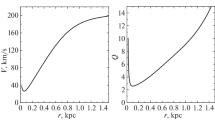Abstract
The collapse of a homogeneous, initially spheroidal halo under self gravitation, has been considered. It is found that a weak magnetic field (as is plausible to belong to such a cloud) has little influence on the collapse, except probably sufficiently close to the centre where the gas density, and consequently the magnetic field, becomes rather high. The equatorial collapse is centrifugally balanced at a certain stage, while collapse in the perpendicular direction continues. A thick stellar disk is formed within a time-scale <3×109 yr. Brisk star formation takes place while the collapse of the gaseous disk is still in progress. This gives rise to the halo stars with low metal content and high Z-motion. A bulge is formed at the centre simultaneously. This is the first phase of formation of a disk galaxy. The thin disk is formed at a later stage as the remaining primordial gas and the gas released by the evolution of stars in the thick disk gradually settles on to it.
The presented model is rather a crude one. Many aspects have not been considered, and many details have not been worked out. It is hoped that a more detailed and comprehensive model will be arrived at in the future.
Similar content being viewed by others
References
Brosche, P.: 1970,Astron. Astrophys. 6, 240.
Fall, S. M. and Efstathiou G.: 1980,Monthly Notices Roy. Astron. Soc. 193, 189.
Gott, J. R. and Thuan, T. X.: 1976,Astrophys. J. 204, 649.
Hoyle, F.: 1953,Astrophys. J. 118, 513.
Jones, B. J. T. and Wyse, R. F. G.: 1983,Astron. Astrophys. 120, 165.
Kashlinsky, A.: 1982,Monthly Notices Roy. Astron. Soc. 200, 585.
Larson, R. B.: 1976,Monthly Notices Roy. Astron. Soc. 176, 31.
ostriker, J. P. and Thuan, T. X.: 1975,Astrophys. J. 202, 353.
Rees, M. J. and Ostriker, J. P.: 1977,Monthly Notices Roy. Astron. Soc. 179, 541.
Sandage, A.: 1963,Ann. Rept. Dir. Mt. Wilson and Palomar Observatories, p. 16.
Sandage, A., Freeman, K. C., and Stokes, N.: 1970,Astrophys. J. 160, 831.
Silk, J. and Norman, C. A.: 1981,Astrophys. J. 247, 59.
Spitzer, L., Jr.: 1968,Diffuse Matter in Space Interscience Publ., New York; p. 220.
Spitzer, L., Jr.: 1978,Physical Processes in the Interstellar Medium, Wiley Interscience Publ., New York, p. 243.
Tinsely, B. M. and Larson, R. B.: 1978,Astrophys. J. 221, 554.
Wang, Y. M. and Scheuerle, H.: 1984,Astron. Astrophys. 130, 397.
Author information
Authors and Affiliations
Rights and permissions
About this article
Cite this article
Basu, B. A mathematical model of the initial stage in the formation of a disk galaxy. Astrophys Space Sci 119, 201–206 (1986). https://doi.org/10.1007/BF00648847
Received:
Issue Date:
DOI: https://doi.org/10.1007/BF00648847




